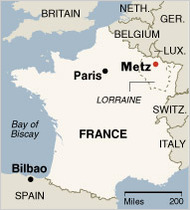Speaking of the Guggenheim Bilbao/Frank Gehry, which I was here before detouring into jazz yesterday, it looks as if revisionism — or reality — is starting to set in.
 Last Friday, a New York Times article about Metz described how the city is hitching its wagon to the star of a Centre Pompidou-Metz, hoping to attract 200,000 visitors annually:
Last Friday, a New York Times article about Metz described how the city is hitching its wagon to the star of a Centre Pompidou-Metz, hoping to attract 200,000 visitors annually:
Metz has dreams of becoming a European artistic hub, but that will mean cashing in on what many here, including the mayor, call “the Guggenheim effect,” after the urban transformation of Bilbao, Spain, that centered on the striking Guggenheim museum designed by Frank Gehry.
But then the article brought Metz down to earth.
For Thomas Werquin, an economist and the president of an association that studies urban planning projects, the Guggenheim effect is a “myth.”
“A lot of cities now think that having a big, branded museum is enough to make a name for themselves; it’s a big problem,” he said. “The museum is a great element of urban marketing, but not a cultural policy.”
For Mr. Werquin, the Guggenheim museum only served as an “accelerator” in Bilbao’s already strong and determined urban policy.
I’m with Werquin. Museums are being asked to do too much. They’re about art, not tourism — except when those two things align.
The article had one very interesting revelation (to me), however: It said that Pompidou-Metz “will have the right to choose among the 65,000 artworks that the Pompidou center in Paris, the largest contemporary collection in Europe, has in storage.” In storage? How will that draw people?
Sounds to me as if they are counting mainly on the architecture (pix here), not a good bet for sustained tourism.
Map: Courtesy The New York Times
